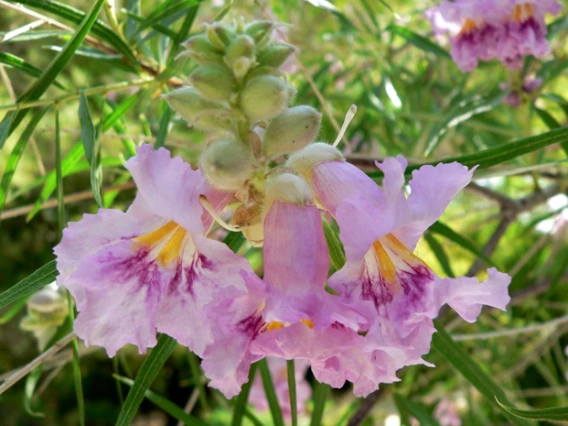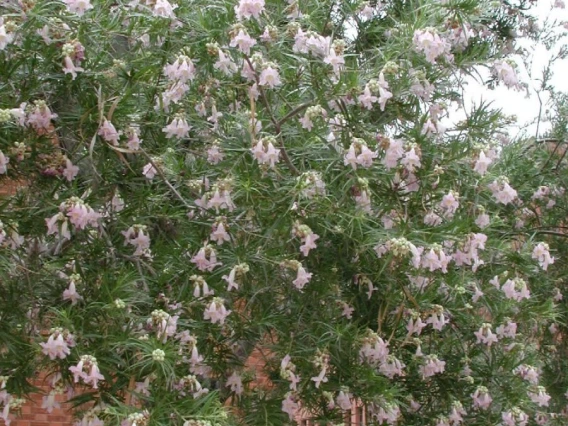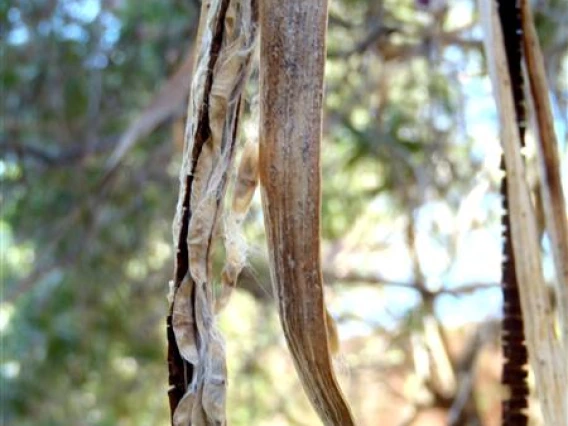


Botanical Name: Chilopsis linearis
Common Names:
English: Desert Willow
Spanish: Mimbre
O'odham: A:n
Family: Bignoniaceae (trumpet-creeper)
Rain Garden Zone: C. linearis thrives in the terrace Rain Garden Zone, but may also grow well in the bottom Rain Garden Zone provided is has adequate drainage.

Reproduced with permission from "Rainwater Harvesting for Drylands and Beyond" by Brad Lancaster, HarvestingRainwater.com
Flowering Season: April--September (3)
Harvest Season: Late summer--early Autumn
Harvest Techniques: Harvest dried pods in late summer or early autumn, before they have split open.
Planting Season: Late summer (3)
Landscape Cultivation: C. linearis may be cultivated from seed or from semi-hardwood cuttings in late summer. Seeds should be gathered from dry pods in late summer and into autumn. No seed treatment is necessary for germination. (1)
Characteristics: C. linearis is a deciduous shrub or small tree reaching a height of 12 meters, with leaning and twisting trunk or trunks. Yound desert willows have gray-brown, smooth bark, while mature desert willows have dark brown-black, deeply fissured bark. The leaves are long-tapered (10-25cm in length; 4-6mm broad), opposite or alternate and a lustrous green. Desert willow flowers are bilateral, loose conical structures of a white, pink, or magenta color. (6)
Ecology: Hummingbirds and insects feed on the nectar of C. linearis, and granivorous birds feed on its seeds. C. linearis is also the larval host of the white-winged moth, and generally attracts birds, butterflies, and hummingbirds. Additionally, the desert willow may be used for erosion control. (3)
Ethnobotany:
Food:
Both the flowers and the seed pods are edible (5).
Domestic Animals:
Honeybees that feed on the nectar of the desert willow produce a sweet honey. The seeds can be used as feed for grazing cattle.
Other:
The flowers of the desert willow can be used medicinally, brewed into teas for coughs and other bronchial problems. (3) Additionally, the flowers can be used for fragrance. The trunk of the branches of the desert willow makes good firefood. Desert willow is a great shade tree and provides shelter for companion plants and animals (4).
References:
- Nokes, J. (2001) How to grow native plants of Texas and the southwest. Austin, TX: University of Texas Press.
- https://toccatlas.plantpress.net/index.htm
- https://www.wildflower.org/plants/result.php?id_plant=chli2
- Lancaster, B. (2006) Rainwater harvesting for drylands and beyond. Tucson, AZ. RainSource Press.
- https://pfaf.org/user/Plant.aspx?LatinName=Chilopsis+linearis
- https://calscape.org/Chilopsis-linearis-(Desert-Willow)
For more information on this species, see the Campus Arboretum species description pages.
Go to the next tour stop: chuparosa page or Return to the main Dunbar Spring tour page

